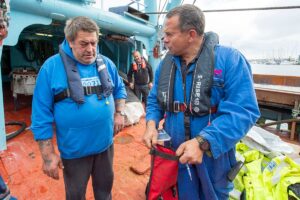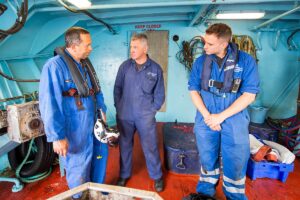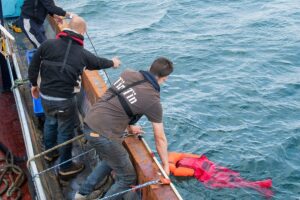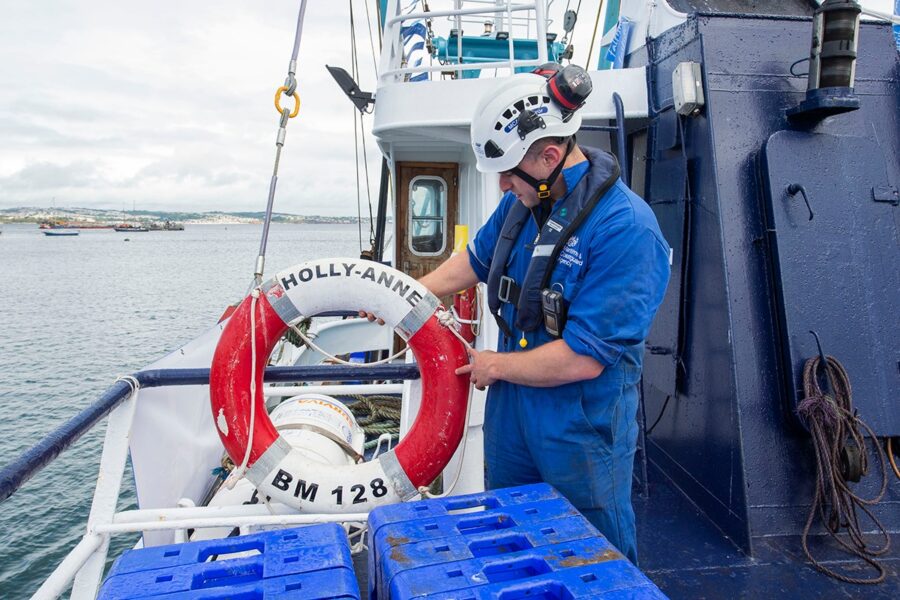Preventing accidents starts with getting to grips with risk assessment, explains Mark Lennon from the MCA Survey and Inspections team
Commercial fishing carries high risk to health and safety. Accident, death and serious injury rates are over 20 times higher than in other sectors. While there are significant inherent risks in working at sea, and in the work carried out onboard a fishing vessel, many MAIB reports conclude that accidents on fishing vessels could have been avoided through appropriate and systematic application of health and safety regulations.
The Merchant Shipping and Fishing Vessels (Health and Safety at Work) Regulations 1997 (as amended) cover the work activities of anyone working on a fishing vessel, regardless of their employment status. Employed fishermen and self-employed share fishermen are all protected by the International Labour Organisation Work in Fishing Convention (ILO 188), and the fishing vessel owner has responsibilities towards anyone working on their vessel.
The ILO 188 Work in Fishing Convention came into force in 2019 to improve living and working conditions onboard fishing vessels. Part of this convention is the requirement to have written risk assessments.

Holly-Anne’s mate Peter Vandeputte goes over the MOB drill with MCA principal consultant marine surveyor Roger Gee.
Regulations can be difficult to read and interpret, but the skipper, and the vessel’s owner or operator, need to be aware of regulations that they are responsible for. In many instances, the skipper is the owner of the vessel and is the responsible person. However, where the skipper is not the vessel owner, the owner has the responsibility to ensure that the skipper is operating the vessel safely.
While the vessel owner always has overall responsibility, it is recognised that if they are not onboard their vessel, they may have limited control of day-to-day activities. The regulations provide that responsibility for health and safety also rests with any person who is in control of any particular matter. This will most likely be the skipper in respect of day-to-day running of the vessel. Part of that responsibility is a duty to ensure the health and safety of fishermen and other persons, so far as is reasonably practicable.
In order to fulfil their duty to ensure health and safety, the vessel owner must ensure that a suitable and sufficient risk assessment has been carried out and documented for all work activities on the fishing vessel. Measures should be taken to reduce risks as far as is reasonably practicable.
The skipper and crew should be closely involved with the risk assessment, to take advantage of their practical knowledge and experience of the work, what can go wrong, and how to prevent that. Risk assessments must be documented to ensure availability and familiarity for all onboard, and should be made available during an inspection. However, the vessel owner has overall responsibility for ensuring that the risk assessment has been carried out and acted upon.
So what is a risk assessment? It is the process of thinking about possible dangers, and deciding what you can reasonably do to prevent or guard against them. Risk assessments may seem complicated – but when broken down into steps, they can be easily understood and, as a result, become simple and meaningful. These steps are:
- Identify the hazards
- Decide who might be harmed and how
- Evaluate the risks and appropriate control measures
- Record your findings
- Review your risk assessment and update it.

Dave Passmore from Protec-Fire discusses fire drills with MCA surveyors Roger Gee and Charles Blyth.
Step 1: Identify the hazards
Almost anything can be considered a hazard – what may seem a hazard to one person may not seem hazardous to another. Therefore, it is important to include all your crew in identifying the hazards. Take a walk around your vessel and make a list of the hazards.
Examples might be:
- Falling overboard
- Unguarded machinery
- Shooting the gear
- A slippery deck
- Open hatches
Step 2: Decide who might be harmed and how
Once the hazards have been identified, consider how likely they are to happen and who they could happen to. Remember to consider any inexperienced or young crew members, as they may not be aware of the hazards. A hazard may not only cause harm to a crew member, but may also harm the vessel.
For example, when shooting the gear, an inexperienced crew member may not be aware of the dangers and could get caught up in the gear – or an experienced crew member might attempt to free snagged gear in a dangerous location.
Step 3: Evaluate the risks and appropriate control measures
Now think about what can be done to avoid or minimise a potential hazard. Can the risk be eliminated, or can control measures be put in place to isolate or minimise the risk?
- Option 1: Eliminate the hazard. The first aim should be to eliminate hazards. An example would be to remove work activity from the deck edge.
- Option 2: Isolate the hazard. If it is not possible to eliminate a hazard completely, it should be isolated in order to separate crew members from the danger. For example, this could mean putting guards around moving parts.
- Option 3: Minimise the risk. If it is not possible to eliminate or isolate the hazard, action should be taken to minimise the possibility that it will cause harm or, at least, to reduce the harm caused. For example, this could be done by providing protective clothing and equipment. It may also call for training, including onboard training, and a discussion of how to improve procedures to improve their safety
For example, when shooting gear, what safeguards could be put in place to prevent a crew member from getting caught up in the gear? These could be:
- Mandatory safety training
- Onboard familiarisation
- Onboard drills
- Marked areas for safe standing
- Good communications between all crew
- Wearing of PFDs and/or safety harnesses
- Emergency stops/cut-outs for equipment.

Holly-Anne’s crew practise an MOB drill, with Roger Gee watching the proceedings.
Step 4: Record your findings
The next step is to record your findings and implement them. Use a simple form to write down your risk assessment, and ensure all your crew are aware of it and understand it.
Sign up for the free Safety Folder service for help with the process of recording risk assessments and to access templates for recording this information.
Step 5: Review your risk assessment and update it
Risk assessments must be reviewed annually as a minimum. However, if any changes are made to the vessel, be it fishing methods or new crew, or if any incidents have happened in relation to a hazard, this review must be carried out immediately.
On fishing vessels, there are obvious dangers such as sinking and falling overboard, but it is important to consider any additional risks that may arise during day-to-day operations, and where appropriate to put in place additional or alternative safety measures. Crew may also come across issues, or have near misses, which should be raised so that risk assessments are reviewed on a continuous basis.
By carrying out a risk assessment, you are:
- Complying with the regulations
- Making your vessel safer
- Helping to get your crew #Home and Dry. n
Visit: homeanddry.uk for helpful safety resources, videos and information on how to do risk assessments.
The MCA publishes full guidance on ILO 188 at: gov.uk
You can sign up for the free Safety Folder service at: safetyfolder.co.uk
This feature was taken from the latest issue of Fishing News. Subscribe here for more great content on the UK and Irish commercial fishing industry.








